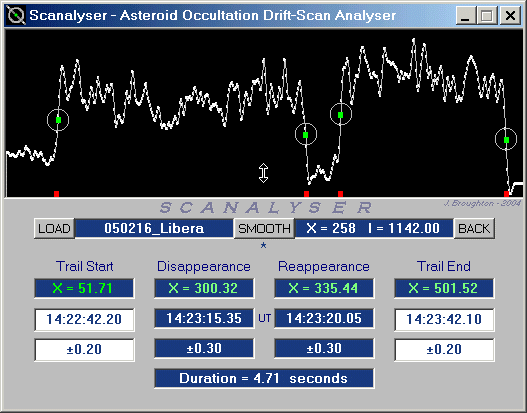A 4.7 second occultation was recorded using the CCD drift-scan technique by Bill Allen in Blenheim. This is the first successful observation using this method from New Zealand.
View the Updated Prediction
Observational Data:
Observer's Name : Bill Allen
Aperture (cm) : 32
Focal length (cm) : 480
Type (e.g. SCT; Newtonian) : Dall Kirkham with focal reducer
Magnification : -
Observing site name : Vintage Lane Observatory
Longitude (DD MM SS ; East +ve) : +173 50 30
Latitude (DD MM SS ; South -ve) : -41 29 45
Height above Sealevel (metres) : 30
Geodetic Datum (e.g.WGS84,NZ1949): NZ1949
Height Datum (if known) : MSL
Sky Transparency (Delete two) : Good
Star Image Stability (Delete two): Good
Other Conditions:
(Wind, Clouds, Lights, etc.): -
TIMINGS: (PLEASE REPORT IN UNIVERSAL TIME)
Time Source (e.g. WWVH, GPS) : Loader time box and National Radio time pips.
Recording method (e.g. tape) : Drift Scan
Could you see the Asteroid? : Yes
Approx. Limiting Magnitude : 16
| Estimated |
Universal Time | Reaction | Accuracy, Remarks
h m s | Time (sec) |
COLUMN FORMAT TO USE---> __:__:__._ _._ _________________)
Started Observing : 14:22:42.2 N.A. 0.2
Disappearance At : 14:23:15.3 N.A. 0.3
Reappearance At : 14:23:20.0 N.A. 0.3
Stopped Observing : 14:23:42.1 N.A. 0.2
Duration : 4.7 N.A. 0.05
Drift-scan trace:

Data was reduced using the SCANALYSER software prepared by John Broughton.

Discussion:
The IRAS-estimated diameter of this asteroid is only 29 km, corresponding to maximum expected duration of about 3.5 seconds. So Bill's occultation length of 4.7 seconds indicates that the asteroid is significantly longer than this in at least one axis. Assuming that Bill might have seen an approximately central event, his observation also suggests that the very narrow path shifted by perhaps one-half track width to the north.
The "rank" of the updated prediction was only 53, so Bill's observation shows that Steve Preston's updated prediction for this event was very good.
No other observations were obtained as much of the central part of New Zealand was under cloud on the night.
[Top of Page][Return to Home Page]